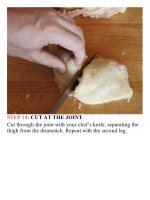The food lab better home cooking through science ( PDFDrive ) 133
Bạn đang xem bản rút gọn của tài liệu. Xem và tải ngay bản đầy đủ của tài liệu tại đây (132.87 KB, 2 trang )
as well as to control the way the eggs come together by
moving them as they cook. For my testing, I decided to
begin with just plain eggs in order to gauge the effects of
stirring and other mechanical actions. The only additive I
used was a bit of butter in the pan to prevent them from
sticking.
A few things became clear immediately. The difference
betweencreamyscrambledeggsandfluffyoneshasmostly
to do with the amount of air they contain at the end. As
beaten eggs are heated in a skillet, their proteins begin to
set. At the same time, the moisture within them begins to
evaporate, causingpockets of steam and air to build up
within the eggs. Vigorous stirring or shaking will cause
these pockets of steam and air to rupture, making the eggs
denser. So, for the fluffiest scrambled eggs, your goal is to
minimize the movement of the eggs in the pan, gently
folding and turning them just enough to get them to cook
evenly into large, golden, tender curds. For creamy eggs,
constant stirring is preferable, to remove excess air and get
theeggproteinstosetupcloselywithoneanother,resulting
inadense,almostcustard-likescramble.
Heat had a great effect on final texture as well. When
cooked over very low heat, even gently folded eggs won’t
gettoofluffy.Thisisbecausethere’snotenoughenergyin
thepantocausewatervaportoformortocauseairbubbles
to expand vigorously. So, for fluffy scrambled eggs, you
need to use relatively high heat (though if you let the pan
get too hot, you risk overcooking—or, worse, browning—
your eggs), while for creamy eggs, cooking over low heat
givesyoumuchmorecontrolovertheirtexture.
Additives
What about common additions to eggs—water, milk, and
the like?There are basically two things they can do. First,
they add some water to the mix, which makes for fluffier
eggs (more water = more vaporization). Dairy ingredients
also add fat, which can impede egg proteins from linking
with each other, creating a more tender curd. This chart
sumsitallup:
ADDITION
EFFECT
ON
TEXTURE
AND
FLAVOR
Nothing
Eggscook
fastestbut
aretougher
Water
Increased
fluffiness,
diluted
flavor
HOWIT
WORKS
Extrawater
meansmore
vaporization
occurs,
creating









